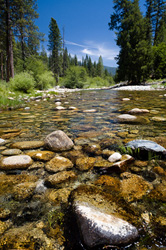Air Pollution Puts 2 Million Americans at Risk of Cancer, EPA Says
by www.SixWise.com
Two million Americans, living in close to 600 U.S. neighborhoods, are exposed to air pollution at levels that increase their risk of cancer significantly, a new report from the U.S. Environmental Protection Agency (EPA) has found.

As you might suspect, the U.S. locations with the cleanest air tend to be those most removed from industry and large populations. |
While the EPA said all Americans have an increased cancer risk of greater than 10 in a million due to air pollution, those in the most polluted areas face cancer risks of greater than 100 in a million -- a level the EPA generally regards as unacceptable.
For comparison, the average cancer risk in the United States is 36 in 1 million, according to the National-Scale Air Toxics Assessment.
"If we are in between 10 in 1 million and 100 in 1 million we want to look more deeply at that. If the risk is greater than 100 in 1 million, we don't like that at all ... we want to investigate that risk and do something about it," Kelly Rimer, an environmental scientist with the EPA, told The Associated Press.
The Biggest Sources of Air Pollution?
Automobiles account for about 30 percent of the cancer risk from air pollution, according to the EPA. The biggest contribution to air pollution actually comes from burning coal and oil, and the subsequent release of cancer-causing benzene into the air (vehicle exhaust also releases benzene).
Other sources of cancer-causing air pollution include:
-
Industry emissions (accounting for 25 percent of cancer risk)
-
“Background” pollutants, with no none emission sources (45 percent of risk, with carbon tetrachloride contributing nearly half of this risk)
Which Cities Have the Worst Levels?
Though the just-released study is based on 2002 data (so it doesn’t account for air pollution changes since then), the analysis found parts of Los Angeles, California and Madison County, Illinois to have the highest air-pollution-related cancer risks in the United States, with risk levels ranging from 1,200 in 1 million to 1,100 in 1 million.
Two neighborhoods in Allegheny County, Pa., and one in Tuscaloosa County, Ala., made up the next worst areas.
How can you find out what the risk is in your neighborhood? You can view this summary risk map from the EPA to find out.
"Air toxic risks are local. They are a function of the sources nearest to you," Dave Guinnup, who works with risk assessments for toxic air pollutants at the EPA, told The Associated Press. "If you are out in the Rocky Mountains, you are going to be closer to 2 in a million. If you are in an industrial area with a lot of traffic, you are going to be closer to 1,100 in 1 million."
How Big of a Health Risk is Air Pollution, Really?
About 4 percent of deaths in the United States can be attributed to air pollution, according to the Environmental Science Engineering Program at the Harvard School of Public Health. And, alarmingly, in the most polluted cities it has been estimated that lives are shortened by an average of one to two years, according to research by the American Cancer Society and Harvard University.
While everyone is at risk from polluted air, certain groups are most at risk, according to the American Lung Association. These are:
-
People with asthma (over 2.2 million children and 5.5 million adults with asthma live in areas with very high levels of ozone)
-
The elderly and the young (over 10.2 million adults over age 65 and nearly 24 million children live in counties with unhealthful levels of ozone)
-
Those with chronic bronchitis and emphysema (nearly 2,9 million people with chronic bronchitis and over 1.2 million with emphysema live in counties with unhealthful levels of ozone)
-
People with cardiovascular disease (over 20 million people with cardiovascular disease live in areas with unhealthful levels of short-term particle pollution)
-
People with diabetes (over 4.6 million people with diabetes live in areas with unhealthful levels of short-term particle pollution)
What Can You do to Minimize Your Air Pollution Risks?
If you live in an area with heavy air pollution, the best way to reduce your risk is to relocate to a location with cleaner air. Of course, this isn’t practical for most people so the next best alternative is to minimize your exposure to toxic air pollutants as much as possible. To do this:
-
Purify your indoor air. The PIONAIR Air Treatment System, which Sixwise.com highly recommends, uses photocatalysis, which is designed to oxidize organic odors, germs, and fungi. The PIONAIR technology creates ultraviolet light rays, safe levels of ozone, and passive negative ions as part of your air treatment. This is not just any old air filter -- it is an air purifier that duplicates Nature's own methods of air cleaning and revitalization.
-
Keep dirt and dust out of your home. A few high-quality mats, like the Waterhog Grand Premier Mats, placed strategically around your home (such as in doorways and other highly trafficked areas), will go a long way toward reducing the amount of dirt and dust in your home in the first place. Once inside, that dirt gets circulated into the air and you breathe it in.
Purify Your Air, Fast, With PIONAIR

With the PIONAIR Air Treatment System you can remove smoke, dust pet dander, mold, bacteria, pollen and more from your home and office air so you can breathe freely.
All PIONAIR Systems include a 30-Day Money-Back Guarantee!
And for a LIMITED TIME ONLY, Get $30 Off Each PIONAIR Air Treatment Unit, Plus FREE SHIPPING and a FREE MiniMate Refrigerator Unit!
|
- When pollution is heavy, be sure to drink plenty of fluids (non-alcoholic) to keep your respiratory tract moist.
- Avoid high levels of smog and pollution. These are typically highest during the midday and afternoon. If you're in a high-risk group, don't go outside when ozone levels are high.
- Exercise when the air is cleaner. When you exercise (or work strenuously), you draw air more deeply into your lungs, and therefore risk more damage from air pollution. To protect yourself and get the numerous health benefits of exercise, avoid exercising near congested streets and during rush-hour traffic, and definitely if there's a wildfire burning in your area.
- Clean your home properly. Removing excess dust and dirt is important to your air quality. However, if you use ordinary rags or mops, you will simply push dirt from one area to another -- NOT pick it up and eliminate it like you intended.
That's why we recommend hospital-grade PerfectClean mops, cloths and dusters to give your home a microscopic level of clean. Every item is built with PerfectClean's revolutionary ultramicrofiber construction that enables them to reach deep into microscopic crevices (NO other cleaning tool available even comes close!) and remove everything in their path: all forms of dirt, dust, hair, dander, and the biological contaminants too small to see with the naked eye.
Recommended Reading
15 Cities Added to EPA’s “Sooty Air List”: Is Yours on the List?
Surprising Facts About Air Pollution and How to Protect Yourself
Sources
EPA National-Scale Air Toxics Assessment
NYTimes.com June 24, 2009
Yahoo News June 24, 2009